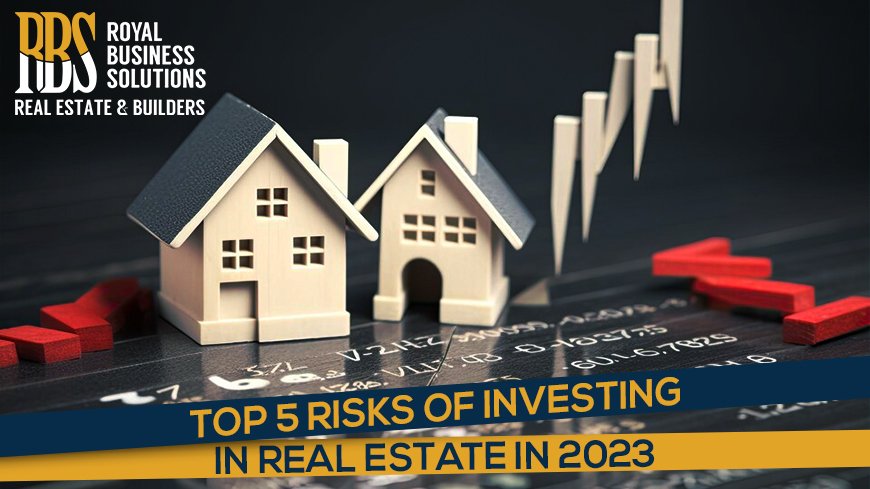- September 26, 2023
- Posted by: Muhammad Afzaal
- Category: Blogs

Real estate has been perceived as a promising investment, offering a stable avenue for wealth creation and income generation throughout history. Nonetheless, similar to any investment, it carries basic risks influenced by economic circumstances, market dynamics, and other variables. This blog post will outline the primary top 5 risks of investing in real estate during this year.
Introduction
The ‘Top 5 Risks of Investing in Real Estate 2023‘ will provide insights for organizing effective strategies and solutions. Real estate stands out as the most lucrative sector for return on investment (ROI) in Pakistan. Consequently, residential property rates in the country have surged from PKR 5,218 per square foot to PKR 8,316 per square foot, marking a notable increase of 59.37% over the past five years.
Being a smart investor, it’s essential to understand that risk is inherent to the business, but adopting suitable strategies and solutions can mitigate potential losses.
The property tycoons are well known for providing never-before-seen comforts at affordable pricing, check out Pakistan’s Top 10 Real Estate Tycoons.
Top 5 Risks of Investing in Real Estate
Basically, risk is a fundamental aspect of any business endeavor. However, it’s crucial to be proactive in recognizing and understanding risks early on to prevent any potential issues in the present or down the line. The blog comprehensively addresses the primary five risks that associates with real estate investments.
Here are the top 5 key risks to consider in real estate investment:
1. Real Estate Market Volatility
The real estate market is inherently volatile, influenced by a range of factors i.e. economic demand and supply dynamics, shifts in government policies, and unforeseen domestic and global occurrences. However, as smart investors, it’s imperative to stay continuously informed and updated.
Here are some crucial factors contributing to real estate market volatility:
- Economic Conditions
- Interest Rates
- Market Demand and Supply
- Government Policies and Regulations
- Housing Affordability
- Development and Construction Trends
- Technological Advancements
- Financing and Lending Practices
2. Location of the Property
The location of a property should be a top priority for any investor, as strategically positioned properties can yield substantial profits. Therefore, as an informed investor, carefully assess the ideal location for both residential and commercial purposes.
When considering a property purchase, consider the following:
- Is the property situated in an urban or suburban area?
- Are schools, grocery stores, and hospitals in close proximity?
- Is the location safe?
- Is the location profitable?
3. Loss in Cash Flow
Cash flow refers to the remaining funds after covering the expenses, taxes, insurance, and generally mortgage payments in the real estate business. In cases where the incoming funds are less than the outgoing funds, it results in a negative cash flow, indicating financial losses.
Several factors contribute to negative cash flows, including:
- Underestimating maintenance costs
- Renting the property at low rates
- Extended periods of property vacancy
- Acquiring construction loans with high interest rates
4. Structural Risk
Structural risk arises from underestimating repair and maintenance expenses. When purchasing plots or homes, thoroughly inspect the property to mitigate potential structural risks effectively.
Various risks are outlined below:
- Natural disaster
- Theft or damages
- Usage of poor materials
- Inadequately drafted contracts
- Flawed floor/master plans
- Safety hazards for workers
- Unskilled or inadequate labor force
5. Legal Risk
Paying close attention to legal risk is identically crucial. Alterations or revisions in government policies and regulations can significantly impact your real estate investment. Although legal regulations encompass registration processes, rent control statutes, taxes, tenant laws, and more. Also, all these elements and associated risks demand thorough attention to mitigate potential losses.
If you need to know about high-rise construction check out Why Is High Rise Construction So Important To The Skyline Of A City?
Additionally, understanding and monitoring legislative risks is essential for real estate investors, developers, and stakeholders to adapt and make informed decisions in response to evolving regulatory environments. Furthermore, consulting legal professionals and staying informed about legislative developments is crucial for mitigating these risks.
Here are key legislative factors that pose risks in the real estate sector:
- Taxation Policies
- Rent Control Regulations
- Consumer Protection Laws
- Interest Rate Regulations
- Foreign Investment Regulations
- Zoning and Land Use Regulations
- Building Codes and Safety Standards
Conclusion
In conclusion, investing in real estate in 2023 presents a range of risks influenced by market volatility, property location, cash flow losses, structural risks, and legal risks. Moreover, it’s essential for potential investors to conduct thorough research, stay informed about market trends, and consult with financial advisors to make informed decisions and mitigate these risks effectively. Real estate remains a viable investment, but understanding and managing the risks associated with it are crucial for long-term success in this ever-evolving market.
Furthermore, Lahore Smart City offers its residents exceptional living amenities. Now is the time to check it out!
